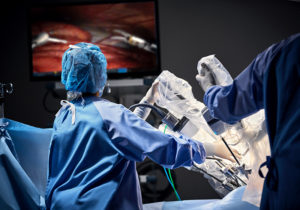
Last summer, Jerry Ahrens in the US visited the emergency room with a stomach ache, which turned out to be a mass on his right kidney. He needed surgery. When it came time for the operation, Dr. Naveen Pokala at University of Missouri Health Care got some help from an assistant he often depends on: a robot.
Six incisions later, the mass was out, Ahrens’ kidney saved.
“I’ve got six small holes, or incisions in various places on the belly where they went in to do that,” Ahrens said. “No major cuts, openings or stitches or anything like that.”
Pokala frequently uses robotic surgery to help his urology patients. It’s part of a growing trend – not just in the United States but in Pokala’s native India. Medical experts say robotic surgery is surging in many parts of the world because it offers many benefits, such as reduced recovery time, less blood loss than a traditional surgery and fewer complications.
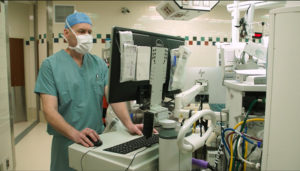
Dr. Daniel Hafez, a neurosurgeon at Washington University in St. Louis, said they have had two robots there for about five years.
“The benefit of the robot right now is to improve the surgical accuracy and guide the placement of our instrumentation – what we call navigation,”he said. “So like GPS tells you where to go when you’re driving, the robot tells us where we are placing our screws” and other instruments.
The most popular robotic system for some surgeries in both countries is the da Vinci, made by the company Intuitive – which reported 1.1 million procedures in the U.S. in 2021, up from 876,000 in 2020. Robotic surgery was on the rise for many years before that, too. A 2020 study looking at nearly 170,000 patients in 73 hospitals found the use of robotic surgery rose from 1.8% of all general surgery procedures in 2012 to 15.1% in 2018.
Over the past 12 years in India, meanwhile, there have been 128,000 successful robotic surgeries, according to Apollo Hospitals.

Doctors from various specialties use robotics for surgeries involving the spine, heart, joints and other parts of the body. Traditional surgery is still an option, but many patients favor robot-assisted operations, said Robert J. Webster III, a professor of mechanical engineering at Vanderbilt University.
The same is true in India, where Dr. Balasubramaniam Ramana is a senior surgeon in the bustling eastern city of Kolkata. Ramana specializes in general surgery and bariatric surgery and began studying robot-assisted surgery in 2018 when he became interested in treating hernias.
“Robotic surgery is making a huge difference in the management of complex patients in multiple specialties,” he said.
A Bevy of Benefits
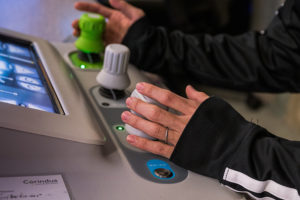
Pokala, director of robotics at MU Health, said that robot-assisted surgeries can actually make his work in urology easier. The robotic device allows him to make smaller holes in a patient’s belly for surgery, leading to less blood loss and a faster recovery.
“The robot actually makes it easier to work well in a confined space,” he said. “With minimal invasive surgery you’re set to sort of putting small holes, which are like a centimeter at the most and some of them are eight millimeters or even smaller. Through those you do the whole operation, so the pain is a lot less” …Because you fill the belly up with air, “it also tends to bleed a lot less patients have a lot less pain and they tend to recover a lot faster.”
After Pokala performed the robot-assisted surgery on Ahrens, he said he got better and better each day.
“After about two to three weeks I would go into town, get out of the house,” Ahrens said.
 Patients in India expressed similar sentiments. The Vattikuti Foundation, a Michigan-based nonprofit founded by the Indian-born entrepreneur and philanthropist Raj Vattikuti, provides education to patients, training to surgeons and funding for surgical technology.
Patients in India expressed similar sentiments. The Vattikuti Foundation, a Michigan-based nonprofit founded by the Indian-born entrepreneur and philanthropist Raj Vattikuti, provides education to patients, training to surgeons and funding for surgical technology.
The foundation releases videos about the experiences of patients and surgeons with robot-assisted surgical technology. In one, a patient explains how quickly she recovered after a kidney transplant.
“I started feeling well and moving better. My hospital staff allowed me to leave my bed the very next day,” Suman Thapar from Kotkapura, Punjab, said in the video.
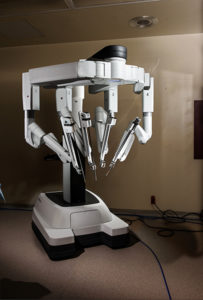
When asked if she was worried about the robot-assisted surgery, she said she felt confident in the doctors’ abilities. “I was not afraid at all, and even after the transplant, I didn’t feel that I had undergone any surgery.”
Mahendra Bhandari, CEO of Vattikuti Foundation and director of robotic research and education at Vattikuti Urology Institute, Henry Ford Hospital, allayed the fears around robotic surgery.
“The robot is totally under the control of the surgeon and does not do anything on its own,” said Bhandari, who along with Indian-American physicians Raj Vattikuti and Mani Menon have featured in ‘Many Voices, One Nation’ exhibit at the Smithsonian National Museum of American History for their contribution to the world of Robotic Surgery through the Vattikuti Foundation.
Bhandari said the decision to use robotic surgery versus traditional surgery should be based on the patient’s individual needs, medical history, and the experience of the surgical team.
Pokala said newer surgeons and medical students are in some cases learning more about robotic medicine than traditional forms of surgery.
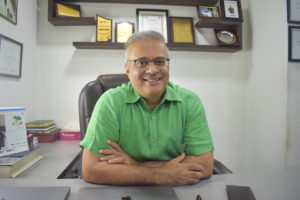 “The newer surgeons probably don’t know how to do an open prostatectomy at all because we don’t do those anymore,” Pokala said of the prostate procedure. “It bleeds a lot less, you know, and when you did them before people would bleed almost two liters to three liters.”
“The newer surgeons probably don’t know how to do an open prostatectomy at all because we don’t do those anymore,” Pokala said of the prostate procedure. “It bleeds a lot less, you know, and when you did them before people would bleed almost two liters to three liters.”
Jason Davis, senior staff surgeon at Henry Ford hospital in metropolitan Detroit, is a total joint replacement surgeon with a specialty in robot-assisted hip replacement. He said one benefit from the surgeon’s standpoint is that it reduces the physical and mental fatigue doctors can feel during surgeries.
That allows doctors to focus on their work, and stay less fatigued throughout their workdays. In a 2020 study in The Journal of Surgical Case Reports, researchers found that surgeons practicing laparoscopic surgery had significantly higher physical fatigue than doctors who performed the same surgery using robot-assisted devices. But the study also said the fatigue laparoscopic surgeons experienced doesn’t reduce the dexterity and overall performance of the surgeon.
 The Question of Cost
The Question of Cost
For patients, the cost difference between traditional, or open, surgery and robot-assisted surgery depends on the type of procedure the doctor performs and the person’s insurance coverage. In most health care systems, the price is similar regardless of the way in which the surgeon chooses to perform the procedure.
“The main cost factor for this is the capital acquisition of the robot itself,” Hafez said. “In spine surgery, the hospital already owns the majority of the equipment, and the patient is paying for the implants used during the surgery. Similarly, for robotic surgery, the hospital must purchase the robot and its associated instruments. It is an expensive investment the hospital is making to improve patient safety and surgical outcomes.”
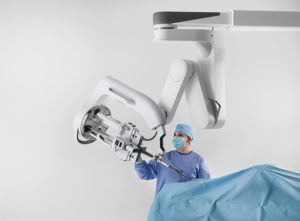 But the benefits are worth the cost, Hafez said.
But the benefits are worth the cost, Hafez said.
“Once you purchase it, then you start getting the benefit of improved accuracy, reduction in OR times, reduction in X-ray exposure to the patient, and reduction in blood loss,” Hafez said. “So you start saving costs per use over time, but there’s definitely a capital acquisition cost up front that is much higher.”
In India, meanwhile, Ramana said there is no uniformity with costs or what insurance covers for robotic surgery. “For example, somebody has a kidney tumor and that needs to be done robotically, it is possible that the insurance company may accept that compared to some other surgery,” Ramana said.
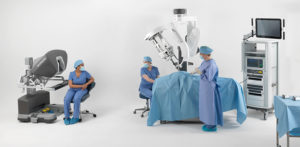
According to the Vattikuti Foundation, robotic surgery costs can be reduced in India because of large volumes of patients.
“Although the initial investment in robotic surgical equipment can be expensive, robotic surgery may ultimately result in lower overall healthcare costs due to shorter hospital stays, faster recovery times, and potentially fewer complications,” Bhandari said.
“However, the cost-effectiveness of robotic surgery depends on several factors, including the type of procedure, the patient’s medical history, and the availability of skilled robotic surgeons.”
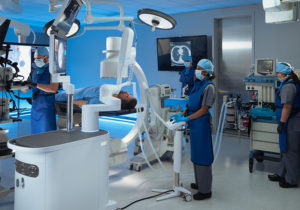 Potential Risks
Potential Risks
But as with any surgery, there are potential risks.
According to Johns Hopkins Medicine, complications from surgery in general include hemorrhaging, shock, and reactions to medicine and anesthesia. The success of a surgery, and the rate of complications, also depend on the skill of the doctors.
Davis said it’s important for patients to do research about potential doctors before choosing one.
“Primarily look at a surgeon and their team and experience rather than shop around for a specific robotic surgeon versus non-robotic surgeon…Because the robot is really just a tool,” Davis said. “If you put in wrong settings or make wrong inputs into it, you can also do some harm.”
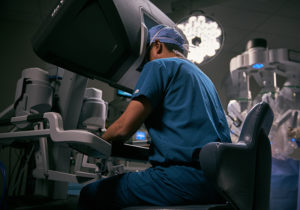
Ramana explained that some of the potential risks of robot-assisted surgeries are similar to laparoscopic surgery. For example, there are risks from anesthesia.
“The other things are robot-specific,” Ramana said. “So robot specific complications would include something like the robotic arm may actually injure the patient’s head or the eye, if it is not taken care of while positioning the robot against the patient.”
But Ramana said harmful complications with the robotic system are rare.
A Robotic Future
As robot-assisted surgeries expand in different places around the world, some people worry the trend could affect the employment outlook for surgeons.
But Ramana said unless we have a “pure robotic evolution,” humans will still have jobs. “This is not like AI taking over the function of normal professionals,” he said. “Robotic surgery is in that sense a misnomer.”
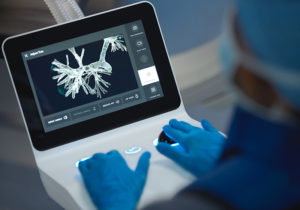
Ramana said that you still need someone who is a trained professional to handle the robot since it does not have the ability to work independently.
“There is a very important feature of robotic surgery for people to understand that the robot is not going to do the surgery for you,” Ramana said. “It’s the surgeon who does the surgery. So the robot is basically an interface between the patient and the surgeon.”
Patients also have the option in many cases to choose between traditional forms of surgery and robot-assisted surgery. Walter Dixon was given the choice between radiation treatment and removing his prostate after finding out that he had a mass growing. He decided to allow doctors to use robot-assisted technology to take out the cancer.
“I was out, woke back up and it was done!” Dixon said. “It was very comfortable, as far as something that major, I was very, very impressed with it.”.
Experts said robot-assisted surgery is only going to continue to grow. In a recent earnings conference call for Intuitive Surgical Inc., CEO Gary Guthart said the company saw an 18% increase in procedures using da Vinci systems in the quarter and full year of 2022. Overall, da Vinci systems were used in a total of 11 million procedures since the commercialization of the machinery within the past year.
He said the U.S. and India were among the countries that stood out.
Webster said he believes that robot-assisted surgery will begin to be integrated into resident and fellowship curricula.
“Typically, exposure starts during residency and really accelerates during a clinical fellowship. During residency, a doctor does rotations, hopping around the hospital to get broad perspectives,” Webster says, “If they find that they like robotic surgery, then they often choose a specialization that uses robotics and sign on to a fellowship program that makes them a true expert in robotic surgery.”
As they join the medical profession, experts say, they will help shape its future.
“It’s going to continue to rise across all surgical specialties. I think all humans are prone to error, no matter how great they are or how technically skilled they are as a surgeon,” Hafez said. “So as tech gets better, and as AI gets better, there is going to be a continued increase in the use and the role of robotics.”
(This report is a cross-country collaboration between the students of Prof. Randall Smith at the Business Journalism department of the University of Missouri, USA and young journalists from India. The project is overseen by Laura Ungar, reporter on the global health and science team at The Associated Press, and journalist Sujoy Dhar, founder of the Indian news agency India Blooms News Service.)
IBNS-TWF



